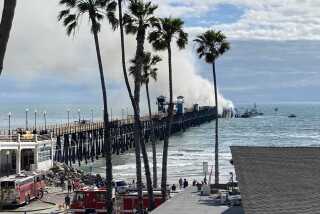Bus Color a Gray Area, Studies Show
Everyone has a theory on why cars keep crashing into Orange Line buses, and one of the most popular puts the blame on their silver-gray paint. A growing chorus is suggesting that buses painted a brighter color might be safer.
But there’s scant evidence to support the theory. And the few studies that suggest it have to be weighed against studies that suggest otherwise.
A New Zealand report suggests that silver -- the color of four of the five buses involved in crashes over the past five weeks -- is, in fact, the safest color. A Spanish study puts white and other light colors in first place. Then, too, one of the five Orange Line buses involved in crashes was bright red.
Conventional wisdom might suggest red is attention-grabbing. But experts say the hue of fire engines and stop signs actually blends into the darkness when light is low.
Buses crisscrossing Southland streets come in all shades. Santa Monica runs the Big Blue Bus. Culver City’s buses are green. Metropolitan Transportation Authority buses come in orange, red or blue.
Across the nation, however, most buses are plain white.
“It is cheaper and easier to maintain,” said Virginia Miller, spokeswoman for the American Public Transportation Assn. “Manufacturers are geared up to produce the basic white bus, and that keeps the costs down.”
When the MTA developed color schemes for its buses, the main consideration was branding, not safety or cost.
“It comes out of our marketing department,” said agency spokesman Dave Sotero. “We wanted the service to be discernible to the public.”
Silver was chosen for the Orange Line “to connote this would be a luxury service, high speed ... that it has rail-like features,” he said.
As the MTA mulls whether it should repaint Orange Line buses, one color consultant suggests taking a cue from an insect.
“The reason why railroad crossings are black and yellow is because it’s from nature. Think of how everyone is afraid of wasps,” said Sandy Dumont, executive director of Impression Strategies Institute, a color and corporate image consulting firm in Norfolk, Va.
“Yellow is the color with the highest visibility in the entire spectrum. It just makes yellow pop to be next to black,” Dumont said.
A 2002 study published in the journal Epidemiology reviewed 57,000 traffic crashes in Spain from 1993 to 1999, and found that white and other light-colored cars were slightly less likely to be crashed into than vehicles of other hues.
“We typically recommend white. It’s just easier to see a white automobile,” said Fairley Mahlum, spokeswoman for the AAA Foundation for Traffic Safety in Washington, D.C.
But a 2003 report in the British Medical Journal found that in the Auckland region of New Zealand, silver cars were associated with the fewest serious injuries.
The study, which examined 571 accidents in 1998 and 1999 that resulted in injury or death, found that silver cars were half as likely to be involved in such crashes as white ones. Brown, black and green cars fared worse than white, the study found.
“We think that conspicuity, ... the relationship between the vehicle colour and the colour of the background against which it is seen by other drivers, is a possible explanation,” researcher Sue Furness explained in an e-mail from New Zealand.
Some researchers question such conclusions. They say aggressive drivers might prefer certain vehicle shades, such as sleek and sporty black, over bland and starchy white -- the color of choice for corporate fleets.
A 2002 study by the Insurance Institute for Highway Safety found only a 3% decline in daytime crashes when cars keep their headlights on during the day, while federal researchers concluded that the lights accounted for a slightly larger, but still small, 5% drop in head-on collisions.
“It’s far-fetched to think that color would have a greater effect than something like daytime running lights,” said Russ Rader, spokesman for the Insurance Institute, a nonprofit research organization in Arlington, Va. “Does anyone think the color of a large bus, right in front of you, is going to affect its visibility? You’re talking about a large, slow-moving vehicle.”
MTA officials said that all five motorists involved in the Orange Line accidents turned illegally or ran red lights.
“The problem we’ve been having is people not paying attention to traffic signals,” said Los Angeles County Supervisor Zev Yaroslavsky, who is a member of the MTA board of directors. “That’s not a color issue.”
Still, he said, “If the problem is color, then it ought to be modified. If there’s evidence that a different look or more distinct color will make a difference, we should implement it.”
More to Read
Start your day right
Sign up for Essential California for news, features and recommendations from the L.A. Times and beyond in your inbox six days a week.
You may occasionally receive promotional content from the Los Angeles Times.






